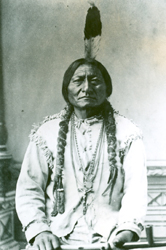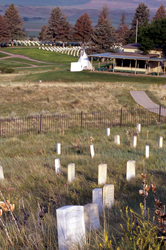Sitting Bull
Updated: August 4, 2020

After proving his courage while still a young boy, Sitting Bull was given his name by his father. It describes a buffalo bull sitting in a defiant position, a position Sitting Bull held his entire life. The Hunkpapa Lakota Sioux warrior and spiritual leader was born around 1831 on the Grand River in present-day South Dakota. He became head chief of the Lakota nation around 1868.
Sitting Bull was eventually forced to live up to his name. In 1874, Lieutenant-Colonel Custer led an expedition to the Black Hills in Dakota Territory. The Black Hills area has long been sacred to the Lakota. The Fort Laramie Treaty of 1868 protected these sacred lands from white settlement. But Custer was there to confirm that gold had been discovered in the Black Hills. Custer brought geologists and newspaper reporters with him so that the entire country would know of the discovery. Times were tough out on the eastern seaboard and prospectors were sure to head for the Black Hills as soon as they learned of the discovery. Sitting Bull knew that if the government had its way, his people would soon be kept off their sacred lands.
In the spring of 1876, the U.S. Army began moving in troops to force the free tribes onto reservations. Sitting Bull could not accept this. He called for a Sundance ritual on Rosebud Creek in Montana Territory. Warriors danced and slashed their arms as a sacrifice to the Great Spirit, the Everywhere Spirit. They were preparing for war. Sitting Bull was the last to finish his dancing. He sent Crazy Horse to lead an attack on the US troops nearby. Crazy Horse was successful. In celebration and for safety, the Indian camp was moved to the Little Bighorn River, still in Montana Territory.
The Little Bighorn River was a place of great change for Sitting Bull. Custer's men surprised the encampment, hoping to rid the plains of the free tribes once and for all. But the Seventh Cavalry was defeated. Crazy Horse anticipated Custer's strategy and defeated it. On one hand, the Little Bighorn represented success for the chief. It would seem that all the trials of Sitting Bull's life culminated on that river. It was, after all, an important victory; one of the great victories by the plains Indians against white encroachment. However, Sitting Bull would spend the rest of his life facing the legacy of that victory.

After being chased for nearly a year, Sitting Bull led his people to Canada where they were safe from U.S. troops. But the near-extinction of buffalo herds left the Lakota with no way to feed themselves. Four years after finding asylum in Canada, on July 19, 1881, Sitting Bull surrendered to the commanding officer of Fort Buford in Montana. Though they were promised their own reservation, that promise was not fulfilled. Sitting Bull and his band were shipped from one reservation to another, sometimes held as prisoners and sometimes forced to work in the fields. In 1885, Sitting Bull even joined Buffalo Bill's Wild West show, though he only lasted a few months. Many photographs still exist of Sitting Bull during this period.
Encyclopaedia Britannica: Sitting Bull
Updated: August 4, 2020

